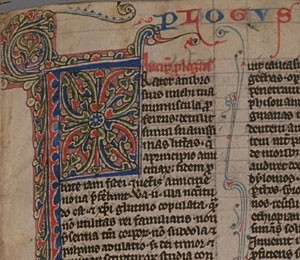Columbia’s Rare Book & Manuscript Library Acquires Early Thirteenth-Century Manuscript Bible
NEW YORK, September 1, 2006 Columbia University’s Rare Book & Manuscript Library (RBML) recently purchased an early thirteenth-century manuscript bible with funds bequeathed by Paul Oskar Kristeller (1905–99), a leading historian of Renaissance philosophy at Columbia. The codex dates from the start of the evolution in bible formatting, organization, and design that took place during the High Middle Ages and holds considerable interest for historians and biblical scholars.

The bible, designated “Western MS 85” in the RBML collections, is a Latin manuscript, copied circa 1220–30 in England. Smaller than the bibles produced in previous decades and lacking the full complement of interpretive prologues that were to become standard, Western MS 85 anticipates the concern for portability that characterized the “Paris” bibles, which only became ubiquitous by the middle of the thirteenth century. But since Western MS 85 still diverges from the “Paris” bible’s more familiar textual canon, chapter divisions, and other standard features, RBML’s new acquisition constitutes an interim phase in the bible’s evolution.
“This manuscript hovers on the edge of developments that shaped the bible physically and intellectually, almost to the form in which we read it today,” said Consuelo Dutschke, curator of medieval and Renaissance manuscripts at the Rare Book & Manuscript Library.
Western MS 85 complements another manuscript bible in the broader Columbia collections, held by the Burke Library at Union Theological Seminary and designated “UTS MS 47.” This bible was also copied in England, but a generation later, during the mid-to-late thirteenth century. The UTS manuscript contains the standard canon of books, chapter divisions, and other features that characterize the “Paris” bible and thus that of the Christian bible for subsequent centuries. Together the two codices offer to the Columbia community and to all interested scholars the opportunity to watch first hand as the bible in England begins to leave the Middle Ages and enter today’s world.
Columbia University Libraries is one of the top ten academic library systems in the nation, with 9.2 million volumes, over 65,650 serials, as well as extensive collections of electronic resources, manuscripts, rare books, microforms, and other nonprint formats. The collections and services are organized into 25 libraries, supporting specific academic or professional disciplines. Columbia Libraries employs more than 400 professional and support staff to assist faculty, students, and researchers in their academic endeavors. The Libraries’ website at http://www.columbia.edu/cu/lweb/ is a gateway to its print and electronic collections and to its services.
The Rare Book & Manuscript Library owns over 500,000 rare books in some 20 book collections and almost 28 million manuscripts in nearly 3,000 separate manuscript collections. It is particularly strong in English and American literature and history, classical authors, children's literature, education, mathematics and astronomy, economics and banking, photography, the history of printing, New York City politics, librarianship, and the performing arts. Individual collections are as eclectic as they are extensive. For more information, please see: http://www.columbia.edu/cu/lweb/indiv/rbml/index.html.
The Digital Scriptorium is an online image database of medieval and Renaissance manuscripts, managed by the Columbia Libraries, intended to unite scattered resources into an international tool for teaching and scholarly research. Among the dozens of participating institutions besides Columbia are the Bancroft Library at the University of California, Berkeley, the Huntington Library in southern California, the Free Library of Philadelphia, and the Houghton Library at Harvard University. The Digital Scriptorium is a visual catalog that allows scholars to verify with their own eyes information about places and dates of origin, scripts, artistic styles, and quality. Because it is web-based, it encourages interaction between the knowledge of scholars and the holdings of libraries to build an ever-enriched and corrected flow of information.